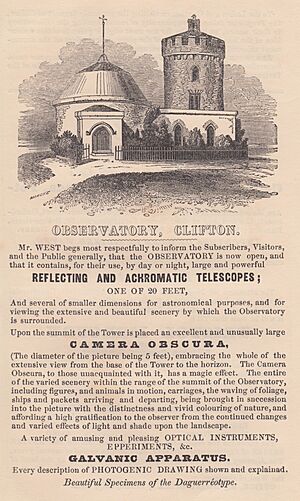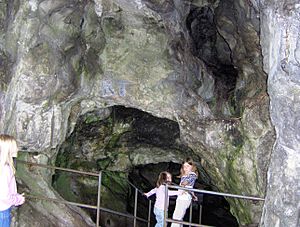Clifton Observatory facts for kids
Quick facts for kids The Observatory |
|
|---|---|

Aerial photo of the observatory showing the relationship to the Clifton Suspension Bridge
|
|
| General information | |
| Town or city | Bristol |
| Country | England |
| Coordinates | 51°27′24″N 2°37′35″W / 51.45663°N 2.62640°W |
| Completed | 1766 |
The Clifton Observatory is a famous building in Bristol, England. It sits high up on Clifton Down, very close to the amazing Clifton Suspension Bridge. This building started its life as a mill, but now it's a special observatory where you can see incredible views.
History of the Observatory
The Clifton Observatory building was first built in 1766. It was a windmill used to grind corn. Later, it was changed to grind snuff, which is a type of tobacco. Because of this, people started calling it 'The Snuff Mill'.
One day, in 1777, there was a big fire. The mill's sails were left turning during a strong wind, and they caught fire. After that, the building was left empty for a very long time, about 52 years!
In 1828, an artist named William West decided to rent the old mill. He paid only 25p a year for it! He turned it into his art studio.
By 1842, William West had transformed the building even more. He made it into an observatory. He added special telescopes and a camera obscura. He would charge visitors a small fee to come and see the amazing views.
In 1977, the building was sold to a company called Honorbrook Inns. However, it was agreed that the public must always be able to visit the camera obscura. In 2015, a local businessman named Ian Johnson bought the Observatory. He also owns other interesting places in Clifton.
What is a Camera Obscura?
William West put a camera obscura in the Observatory. This is a darkened room with a special lens and mirror. It projects a live, moving picture of the outside world onto a table inside the room.
Artists from the Bristol School used this camera obscura. They would draw the beautiful Avon Gorge and Leigh Woods from the images they saw. You can see many of these drawings in the Bristol City Museum and Art Gallery.
The camera obscura at the Observatory has a special lens and a sloping mirror at the top of the tower. These parts work together to project the view downwards. Visitors can see the real image (not a mirror image) on a big, round table. You can even turn the mirror to look in different directions! It has been at the top of Clifton Tower since 1828.
The Secret Cave and Tunnel
William West also built a long tunnel from the Observatory. This tunnel leads to a place called St Vincent's Cave. This cave is also known as Ghyston's Cave or Giants' Cave. It opens up onto the side of the cliff, high above the Avon Gorge.
The tunnel is about 200 feet (60 meters) long. It took two years to build and cost a lot of money back then. It first opened to the public in 1837.
People have known about St Vincent's Cave for a very long time. It was first mentioned as a chapel way back in the year 305 AD. When people have dug there, they found old Romano-British pottery. This shows that the cave has been a holy place and a safe spot for people throughout history. Even though the cave is made of limestone, it doesn't have many of the usual cave formations inside.



